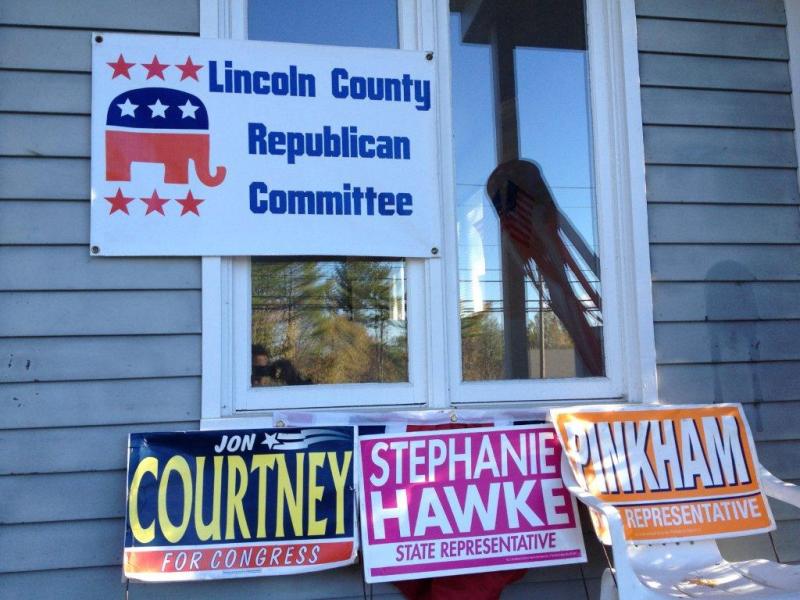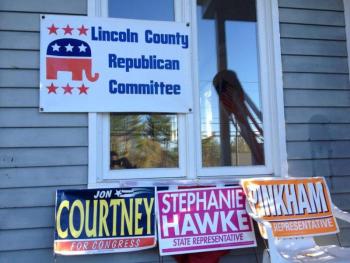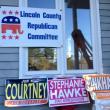Signs, signs, everywhere a sign
In the last couple weeks leading up to November 6, one may have noticed a colorful collection of signs gathering along the roadsides. Love them, hate them, or simply ignore them, political signs are a frequent feature during the election season.
While many local politicians use signs to increase their exposure, this year in Lincoln County there have been noticeably fewer signs promoting Romney and Obama than for candidates in previous presidential elections.
John Gleason, a resident of Newcastle, said for two months he traveled to the Lincoln County Republican headquarters in Damariscotta, and on four separate occasions he has not been able to get a Romney sign.
“My experience has been lousy,” Gleason said. “It’s the most important election of a lifetime and there’s nothing.”
Earl Inman, chairman of the Lincoln County Republicans, said there has been a shortage. Inman said as soon as the signs come in, they go as quickly as they get them.
“Unfortunately we have people that come in and they’ve not been able to get the signs,” he said.
Inman said the local headquarters both buys their signs and has them provided to them by the national headquarters, which also supplies the state GOP.
The Lincoln County headquarters, which is manned mainly by volunteers, has a follow up process where they take names and numbers and let people know when the signs arrive. This week Inman expects hundreds of more signs to come in.
“If you had to look at the whole country, and you were distributing signs for Romney, Maine might not be the first priority,” Inman said.
Lincoln County, located in Maine’s First Congressional District, is represented by Democratic Congressman Chellie Pingree. Since 1992, Maine’s First Congressional District has consistently voted Democratic in presidential elections, according to www.uselectionatlas.org.
The common consensus among local residents on both sides of the political spectrum is that presidential signs are probably set aside for swing states, where the outcome of the election could be pivotal.
Inman said he thinks the political signs are more of a benefit to local candidates to help boost their name recognition.
“Our candidates go out there and try to place signs to get as many out there as possible,” he said. “When you get to the national races, it may be a little different because there is already name recognition.”
A few miles down the road is the Lincoln County’s Democratic Headquarters. The chairman, Valerie Johnson, said since they opened in June, it’s been hard to keep up with inventory.
Johnson, who ordered the lawn signs together with the other county chairs, said they’ve had a supply of them since mid-September. Since October 7, she ordered 500 more signs and they are going fast.
When asked about whether the signs had any impact on voter outcome people from both parties said they weren’t entirely sure.
“It’s a psychological crutch for people not to go insane when they see the other side’s sign,” said Dan Ankeles, an organizer for the Lincoln County Democrats. “Everyone loves to play the sign wars.”
Ankeles joked that he secretly hated signs because they would much rather put volunteers on the phones or at doors then have them come in and take lawn signs. According to Ankeles, voter contact is what matters most in the local campaign.
Alan Pinkham (R-Damariscotta), who is running for state representative in District 51, said he prefers to go door-to-door which allows him to talk to the people he represents; however, he does see some value in lawn signs.
“Most of my signs end up in a supporter’s yard, and if they have enough enthusiasm to put in their yard, that shows their endorsement,” he said. “I don’t know if I put an awful lot of value in signs that are just stuck in a ditch alongside the road everywhere.”
Mick Devin (D-Newcastle), who is running against Pinkham, likened political signs to sporting events. Devin said things don’t get interesting in until he has at least two strikes, and then he needs to start protecting the plate. He said the signs are never going to get him to that second strike.
“It’s part of the game,” Devin said. “You’re shooting a foul shot and all those people that are trying to distract you, those are the signs, you don’t even see them.”
Currently no study exists that proves lawn signs influence voter outcome, or a person’s decision to vote for a particular candidate.
In 2008, Wichita State University political scientist Mel Kahn conducted a study on lawn signs, leading him to conclude at the grassroots level, political signs establish name recognition.
Kahn said, "They don't actually produce voting a certain way. What they do is enable the first element to be reached, of getting candidates known. And they particularly work if they're strategically placed.”
According to The Measurement Standard website, which gauges the effectiveness of political yard signs, supposedly every lawn sign represents an average of six votes for the candidate.
Kahn said among political scientists, there’s a theory that if one can get someone to put out a lawn sign, then that person is committed enough to not just vote for a certain candidate, but also encourages their friends to vote for the candidate as well.
Event Date
Address
United States

























